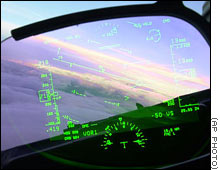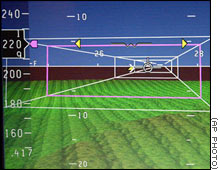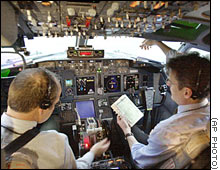Boeing unveils new cockpit technology
March 21, 2002 Posted: 10:50 AM EST (1550 GMT)

|
|
A "head-up display" shows flight
information as seen from a pilot's view on Boeing's aircraft.
|
|
|
SEATTLE, Washington (AP) --
Cruising at about 11,000 feet, the pilot suddenly banks sharply toward
Mount Rainier. Immediately, a digital display inside the cockpit of the
Boeing 737-900 turns the mountain an ominous red. |
| |
The pilot, on a potentially dangerous course, banks away from the
mountain, which is some 80 miles away.
The specially-fitted jetliner, which Boeing is about to show to airlines
from around the world, promotes new technologies which they say could make
flying safer, quieter and easier on the pilot.
Boeing's goal, product marketer Ken Hiebert said during Tuesday's
demonstration flight, is partly to sell new technology in a depressed
market.
But the world's largest airplane maker also believes the host of new
equipment can make it possible for more airplanes to fly more safely at the
same time and in bad weather.
And that will ensure future business for Boeing.
The gamble is unusual for Boeing but perhaps to be expected from a
company that in recent years has started thinking about expanding from its
traditional role as airplane manufacturer and moving into the larger
aviation market.
"For Boeing, you gotta believe this is 'outside the box,' " Hiebert said.
For the average passenger, the test flight is too. To show off the new
technology, pilots Mike Carriker and Ray Craig do things that would likely
send those complimentary in-flight beverages flying.
Banking the plane toward Mount Rainier -- which stands at nearly 14,500
feet -- was one such stunt When Carriker banked the plane away, the mountain
turned a more inviting green on the display.
Digital displays
Elsewhere in the cockpit, there are several other digital displays. One
shows the airplane's position in computer-game Technicolor, a colored
display outlining the landscape while a yellow box displays the projected
flight path. The pilot's job is to keep the airplane inside the box,
although he has help from other technologies on board.

|
|
Boeing hopes computer game-like
technology on board a Boeing 737-900 plane will make flying safer and
more efficient.
|
|
Another gadget uses infrared technology to keep on the lookout for
potential hazards, much like military night-vision goggles. Directly in
front of the pilot, a clear glass screen called a "head-up display" shows
the pilot's position and other essentials in green type, eliminating the
need for the pilot to look down and away from the front windows during
crucial moments during the flight.
A few minutes after passing Mount Rainier, the pilots prepare to land at
Grant County Airport in Moses Lake, about 150 miles away from Boeing Field
in Seattle.
Instead of heading straight for the runway, the pilots make a sort-of
in-flight U-turn and prepare for a curved landing. The plane's course is
tracked on the bright computer game-like display -- bright green grass,
black runway and blue sky are offset by the yellow box that tells the
airplane where it should be at all times.
Such an unusual landing course -- made possible by advanced systems for
tracking more closely where an airplane is at all times -- could eventually
let more planes land faster and from different angles, alleviating the
crowding that causes airplanes to circle while waiting for an open spot to
land.
Hiebert compares it to a freeway -- right now, there's one lane, but
eventually, with advanced technology for determining a plane's position,
planes could take off and land on the equivalent of an eight-lane freeway,
moving more planes more quickly in and out of airports.
Saving headaches
At 400 feet, the pilots pull up sharply, bank dramatically one last time
and prepare for another descent. This one is hands off -- a global
positioning system does most of the work, smoothly dipping the plane onto
the runway using the same satellite-based technology people use in their
cars today.

|
|
New technology by Boeing should make
it easier on pilots, such as Ray Craig, left, and Mike Carriker,
preparing a Boeing 737-900 Technology Demonstrator for a flight.
|
|
That technology is at the heart of Boeing's air traffic management plan,
but -- with only a few airports equipped for the technology -- it's far from
market-ready. The company is still working with the Federal Aviation
Administration on a suggested plan, but it's unclear at this point whether
the government body will adapt the aerospace giant's proposal. Boeing
maintains that the technology, already in use by freight carrier FedEx,
would make air flight cheaper and easier, and also is exploring other
markets for the technology, such as China.
Other technology is already in use, however.
Taking off to fly back to Boeing Field, Carriker and Craig show off a new
way to make airplane takeoffs quieter -- a quick ascent, then a sharp,
stomach-tumbling leveling to quiet the engine over noise-sensitive areas
before going back into the ascent.
Some of the devices, such as the colorful mapping display, are based on
stored maps, while others, such as the infrared display, track what's going
on in real time. At present, only the company's global landing system is
linked to the satellite-based global positioning system.
While all the gadgets could save headaches for air traffic controllers
and residents near airports, Boeing says the package could have the biggest
benefits for pilots, who can more easily spot potential trouble by using the
simple graphic displays in easy-to-see places around the cockpit.
"We think it's decreasing workload and enhancing safety," said Craig, the
test pilot. |